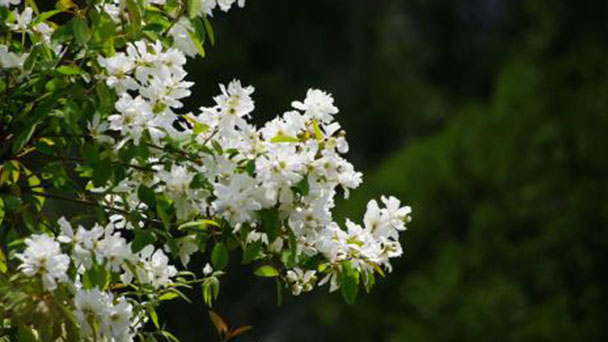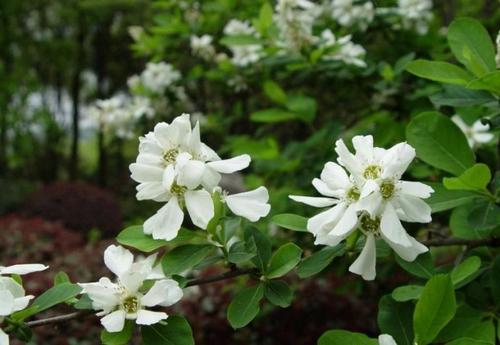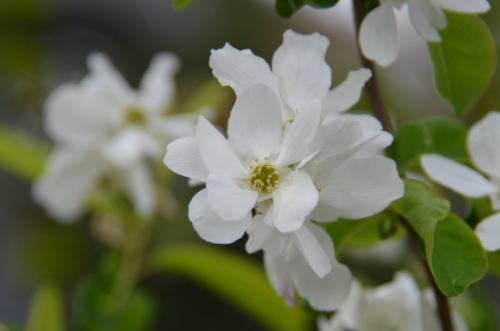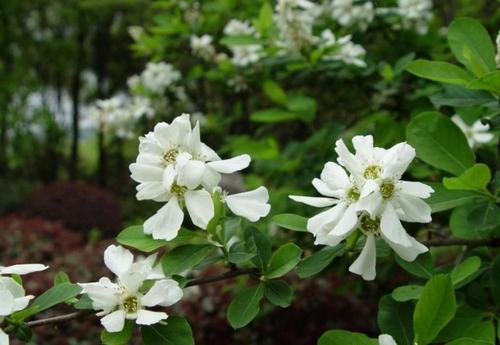Pearl bush profile
Written by Maggie
Aug 31 2021

Pearl bush, scientific name Exochorda, is a shrub of the genus Pearl bush in the Rosaceae family. Pearl Bush was born on a shady hillside at an altitude of 250-500 meters, produced in Henan, Jiangxi, Jiangsu, Zhejiang, etc.
Pearl Bush picture

Morphological features of Pearl Bush
Branch
Pearl bush is a deciduous shrub, 3 to 5 m high, with thin spreading branches. Branchlets are cylindrical, slightly angular, glabrous, reddish brown when young, brown when old; In winter bud is triangular ovate, apex obtuse, smooth glabrous, dark purplish red.
Leaf
Leaf blade is elliptic, elliptic to oblong-obovate, 3.5 -- 6.5 cm long, 1.5 -- 3.5 cm wide, apex obtuse or acuminate rare, base cuneate or broadly cuneate, entire, thinly obtuse above center, glabrous on both upper and lower surfaces; Petiole is short, 5-15 mm long, or nearly sessile; Stipules are absent.
Flowers
Terminal raceme of pearl bush has 6-10 flowers, glabrous; Bracts are small, broadly lanceolate; Flowers are 2.5-3.5 cm in diameter; Calyx tube is shallowly campanulate, glabrous; Sepals are broadly triangular, ca. 2 mm long, apex acute or obtuse, margin sharply serrulate, glabrous, yellow-green; Pearl Bush has 5 petals, obovate, ca. 1.5 cm long, ca. 1 cm wide, apex obtuse, base short clawed, white; Stamens are 15-20, 3-4 in a bunch at disk margin, opposite petals; Pearl Bush has 5 carpels, styles separated.
Fruit
Capsules of Pearl Bush are 5-ridged, pedicels 3-8 mm long, seeds winged.
The flowering period of Pearl Bush is May and the fruiting period is June to August.
Ecological habits of Pearl Bush
Pearl Bush likes light, but is also tolerant to half shade, strong adaptability, drought tolerance and barren soil, has a certain cold resistance, and can be cultivated in Beijing open ground.
Pearl Bush was born on a shady hillside at an altitude of 250-500 meters.
Pearl bush origin
Pearl Bush is produced in Jiangsu and Zhejiang provinces of China, and is now distributed in North and Central China.
Pearl bush growth habits
Pearl Bush likes warm and humid climates. It likes light but also sheltered and has strong cold resistance. Pearl Bush has no high requirements on soil, acid soil, neutral soil and poor soil can grow. Of course, in fertile and breathable soil more vigorous growth, germination ability is stronger.
Pearl Bush propagation methods
Pearl Bush can be propagated by layering, cutting of shoots, sowing and transplanting.

Pearl Bush growing methods
Humidity: Pearl Bush prefers slightly humid to dry climate environments.
Temperature: Pearl Bush has cold resistance. In the summer high temperature period, it can not bear the muggy, otherwise it will enter a semi-dormant state, growth is hindered. The optimum growth temperature is 15 ~ 30℃.
Illumination: Pearl Bush likes a half shade environment, but put in indoor maintenance after a period of time (about two months), it is necessary to move it to the outdoor shaded place for maintenance for a period of time (about a month), so alternate. Put when indoor maintenance, put in the place that has bright light as far as possible, such as the place such as the sitting room with good daylighting, bedroom, study, but want to avoid sunlight direct irradiation to it. In early spring, late autumn and winter, because the temperature is not very high, the sun is not strong, you can give it direct sunlight in the morning and evening, in order to facilitate photosynthesis, it can grow healthily.
Fertilizer water: Pearl Bush likes pot soil dry or slightly wet state, but its roots are afraid of water stains. If the pot water, or give it too frequently watering fertilizer, it is easy to cause root rot.
Insect disease prevention of Pearl Bush
In the cultivation process, if the ventilation is not good, often aphids, night moth, scarab and other pests harm. Once found, promptly use 2.5% deltamethrin 2000 times to control. In case of continuous rain, sultry weather and saturated air humidity, powdery mildew, black spot and other diseases often occur one after another. It can be prevented by spraying the same amount of Bordeaux liquid on the eve of the disease, every 2-3 times a week, and the spread of the disease can be controlled basically.
Pearl Bush main use
Pearl Bush is a beautiful wild ornamental tree with numerous white flowers and beautiful leaves. In the forest it is suitable for lawn, forest edge, roadside and rockery between the rock planting, and can also be used for flower hedge planting. If the evergreen trees in the edge of the group planting, blooming like a layer of snow, the scene is very moving, elegant, such as scattered planted trees or near the courtyard building, is also very suitable. Because of its strong germination and pruning resistance, it is a good tree for pot planting. Its old tree piles, but also the production of bonsai tree stump is excellent material. Root bark, branches can be used for medicine, cure lumbago and so on.

Latest Updated
- Benefits of Bugleweed - 7 Science-backed Health Benefits
- Bugleweed Dangers & Side Effects - Is It Poisonous?
- How to Plant Evergreen Trees - What You Should Know
- When to Plant Evergreens - Grow Guide for Evergreen Trees
- 12 Wonderful Evergreen Shrubs for Your Garden
- 12 Popular Evergreen Plants with Pictures for Beginners
- When And How To Prune A Lilac Bush Like a Pro
- How to Grow & Care for Lilac Vine (Hardenbergia Violacea)
- Japanese Lilac Tree (Syringa Reticulata) Care & Propagation Guide
- Shumard Oak Pros and Cons - What to Know
Popular Articles
- Winter maintenance of Antirrhinum Majus
- How to Grow Terminalia Mantaly Tree
- How to Grow and Care for Crossostephium Chinense
- How to grow Antirrhinum Majus in spring
- Peristeria Elata (Dove Orchid) Profile: Info & Care Guide
- Underwatered Snake Plant (Sansevieria Trifasciata) - Signs And How To Fix
- How to Care for Brazilian Jasmine Plant (Mandevilla Sanderi)
- How to Grow & Care for Graptopetalum Purple Delight in Summer
- Rosa Chinensis (China Rose): Plant Growing & Care Tips
- How to Care for Baby Sun Rose (Aptenia Cordifolia)